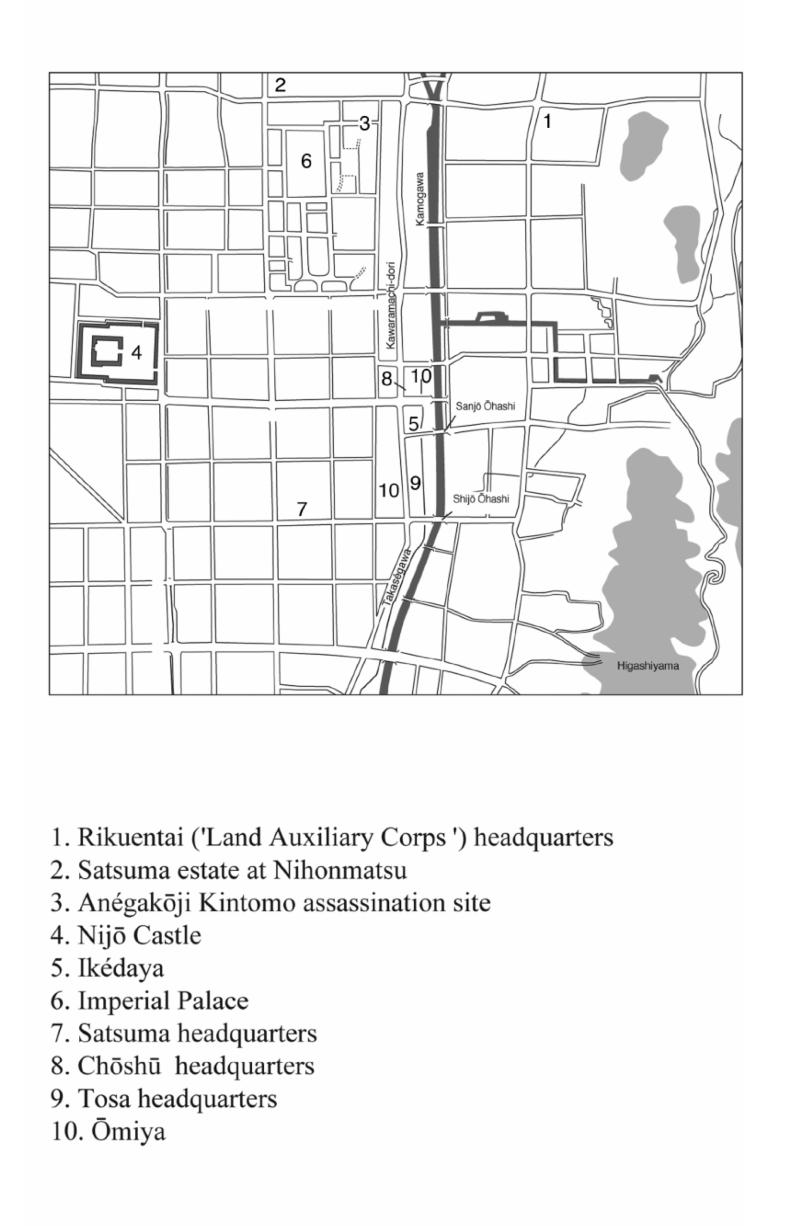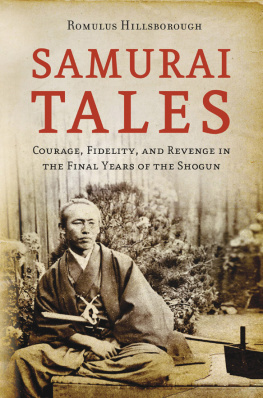Samurai Assassins
Dark Murder and the Meiji Restoration, 18531868
Romulus Hillsborough

McFarland & Company, Inc., Publishers
Jefferson, North Carolina
Romulus Hillsborough is the pen name for Jeff Cohen
LIBRARY OF CONGRESS CATALOGUING DATA ARE AVAILABLE
BRITISH LIBRARY CATALOGUING DATA ARE AVAILABLE
e-ISBN: 978-1-4766-2800-4
2017 Jeff Cohen. All rights reserved
No part of this book may be reproduced or transmitted in any form or by any means, electronic or mechanical, including photocopying or recording, or by any information storage and retrieval system, without permission in writing from the publisher.
Front cover: Arimura Jizamon (from series Kinseigiyuden [Biographies of Loyal and Courageous Men]); author/artist: Ichieisai Yoshitsuya (18221866); originally published in the periodical Nishikie; image courtesy of National Diet Library (Japan)
McFarland & Company, Inc., Publishers
Box 611, Jefferson, North Carolina 28640
www.mcfarlandpub.com
In memory of Miyaji Saichir,
mentor and friend

Map of Kyt
Preface
The Japanese word for assassination is ansatsu, dark murder, and its significance in the samurai-led revolution that was the Meiji Restoration, by which the shguns military government was overthrown and the ancien rgime of the Emperor was restored, forms the substance of this book.
Incidents such as the assassinations of Ii Naosuk in Edo and Yoshida Ty in Kchi, the divine punishment killings in Kyto, and the assassinations of Sakamoto Ryma and Nakaoka Shintar, receive little or only cursory attention in English, though the assassins and their deeds are an indelible part of the popular Japanese literary genre that focuses on the final years of the shguns government. Indeed, knowledge of these assassinationsalong with the ideology, morals, psychology, and human condition of the men behind themdeepen ones understanding of this history. This historical era, which corresponds to 18531868 on the Gregorian calendar, was the dawn of modern Japan. Thus, detailed accounts of dark murder must be a part of any comprehensive study of modern Japanese history.
I have been studying Meiji Restoration history for around thirty years, since I began research for my book on Sakamoto Ryma while living in Tky. In all of my books, I have explored the personalities of the leading actors in this history, presenting it as a human drama of epic proportionthus bringing it to life. My previous book, Samurai Revolution (Tuttle, 2014), is a comprehensive history of the Meiji Restoration and the first ten years of Imperial rule. The present work provides an in-depth overview of the Meiji Restoration, while focusing on significant men and events, and ideology, not expatiated in my previous book.
As such, this book is more than just a chronicle of dark murder in the revolution. It is also an in-depth study of the ideology of the men behind the revolution, including bushid, the code of the samurai, and the philosophy of Imperial Loyalism, which informed the revolution and would become the foundation of the Emperor-worship of World War II. To the best of my knowledge, this is the first book in English to correlate bushid and Imperial Loyalism in their respective indispensible roles in the Meiji Restoration.
The book is comprised of an Introduction, Parts I, II, and III, and an Epilogue. Part I focuses on the assassination of the shguns regent, Ii Naosuk. Ii was the most powerful man in Japan, and with his assassination in Ansei 7 (1860), the revolution got under way. Part II is the first in-depth biographical treatment in English of Takchi Hanpeita, charismatic leader of the Tosa Loyalist Party and mastermind of divine punishment, which wreaked terror on the streets of Kyt in the wake of Ii Naosuks assassination. Takchis important role in the revolution is covered in detail, including his meteoric rise to power and his sudden arrest and imprisonment ending with his stunning seppuku (self-disembowelment). In writing Part II, I referred to Takchis journals, contained in an early biography, Ishin Tosa Kinn-shi (The History of Tosa Loyalism in the Meiji Restoration), published in 1912 (see Chapter 4, note 12 for details about this source); and more heavily to his letters from jail to his wife and cohorts on the outside, published in Takchi Zuizan Kankei Bunsho (Takchi Zuizan-related Documents; Zuizan was Takchis pseudonym). To the best of my knowledge, Takchis letters have rarely, if ever, been used by Western writers. The focus of Part III is the assassination of the genius Sakamoto Ryma. His assassination is shrouded in mystery, and this book provides the first in-depth study of the tragic event in English, based mostly on primary sources. My most important primary sources for Part III include Rymas letters; testimonies and writings by, and interviews of, his alleged assassins; and accounts from people who were either present at the assassination scene or who arrived shortly after the fact. These primary sources, described in Chapter 17, are published in Miyaji Saichirs monumental Sakamoto Ryma Zensh. Other writers to whom I am grateful include Matsuoka Mamoru, Matsuura Rei, Hirao Michio, Kaionji Chgor, Omino Kiyoharu, and Kikuchi Akira, all of whom are cited in the bibliography.
Introduction
Samurai Revolution
Feudal society under the Tokugawa Bakufu (or simply Bakufu) consisted of four classes: warrior (i.e., samurai), peasant, artisan, and merchant, in this descending order. As the supreme power, the Bakufu controlled a land consisting of some 260 feudal domains, called han, each ruled by a feudal lord, or daimy, and his samurai vassals. The Bakufu ruled from its castle at Edo (modern-day Tky), controlled by the Tokugawa family, whose head held the title of shgun, short for seiitaishguncommander in chief of the expeditionary forces against the barbariansconferred by the powerless Emperor.
While dark murder was the catalyst of the revolution, not all of the assassins were revolutionaries. In fact, though the revolution got under way in the spring of Ansei 7 (1860) with the assassination of Ii Naosuk, before the Bakufu would finally collapse nearly eight years later, numerous men on both sides would be cut down by an assassins sword. During the early years of the revolution, until the formation of the shguns notorious hit squad, the Shinsengumi, in the spring of Bunky 3 (1863), most of the assassins were antiBakufu rebels. The Shinsengumi initiated a period of state-sponsored murder by reactionaries committed to preserving the old regime. The most significant of those events was the slaughter of rebel leaders during the Shinsengumis attack on the Ikdaya inn in Kyto in the Sixth Month of Genji 1 (1864), and the double assassination of Sakamoto Ryma and Nakaoka Shintar in Kyto, by another Tokugawa security force, the Mimawarigumi, about three and a half years later.
The trouble started when Ii Naosuk, as regent to an inept shgun, concluded foreign trade treaties against the Emperors will in the summer of Ansei 5 (1858). Like most samurai during those turbulent times, the Imperial Loyalists styled themselves shishi, patriots of high aspirationand they aspired to put an end to Iis rule and later to overthrow the Bakufu. Mindful of Western imperialism in Asia, they professed that in order for Japan to survive in the modern world, the feudal domains must rally around the Emperor in Kyto. The Emperor, not the shgun, they claimed, was the legitimate ruler of Japanthough an Emperor had not wielded power since the twelfth century; and since the beginning of the seventeenth century, Emperors had commissioned successive generations of heads of the Tokugawa family to rule in their stead. The Bakufu had ruled peacefully for two and a half centuries, and its success was to a great extent based on a policy of isolationism. But after the trade treaties, the Loyalists questioned the Bakufus ability to defend the country and even its legitimacy, arguing that since the shgun had yielded to foreign demands for the treaties, he no longer warranted his office.














